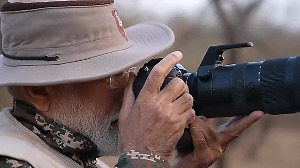A day after making a strident argument that Ram Sethu was destroyed by Lord Rama himself, the Centre has changed tack in the Supreme Court saying that the viability of going ahead with the Sethusamudram project through an alternative alignment has been taken up at the "highest level".
"The suggestion for alternative alignment to avoid Ram Sethu route has been taken as a special case. I have personally taken it at the highest level. It is being scientifically examined. I will come back to you by Tuesday or Wednesday," senior advocate Fali S Nariman told a Bench headed by Chief Justice K G Balakrishnan.
At the outset, Nariman, who continued the arguments for the Centre on the contentious issue, said the suggestion of the Bench to examine the possibility of project through alignment 4 (Rameshwaram to Dhanushkodi) will be examined.
The court was of the view that the alignment 4 could possibly address the issue of religious faith as well as environment concern to the extent that it may be relatively away from the biosphere boundary and marine park.
The Centre had had referred to Kamba Ramayana and Padma Purana to assert that Lord Rama himself had destroyed the Rama Sethu and one cannot worship something which has been destroyed.
The senior advocate commenced touched upon the issue of religious and personal faith by taking the example of temple town of Rameswaram, which he said was the holiest place but has not yet been declared as ancient monument.
However, the Bench, also comprising Justices R V Raveendran and J M Panchal, made it clear that it was not going into the issue of Rameswaram.
Advancing his arguments, Nariman said field experiment and geological survey have not thrown any evidence to suggest that Rama Sethu was a man-made structure.
He said the proposal for taking alignment number 6, out of the various other alignment options, had come for the first time in September-October 2002 and when public hearing for coming out with objections was held in 2004 in six coastal districts of Tamil Nadu. "The issue of Ram Sethu was not raised" the, he said.
During the day-long arguments, the noted jurist's thrust was to counter the contention that environment concerns were not addressed properly before clearing the project.
He contended that though there was no necessity of carrying out comprehensive environment impact assessment for the project, the government tried to fulfil those criteria also.
Nariman said the final report of National Environment Engineering Research Institute (NEERI) in August 2004 had considered environment concern in detail.
The Centre blamed the Tamil Nadu Pollution Control Board for acting in a slow manner in 2005 on the issue of public hearing and alleged that when final decision was taken on the project it rose up with its grievance.






 © 2025
© 2025